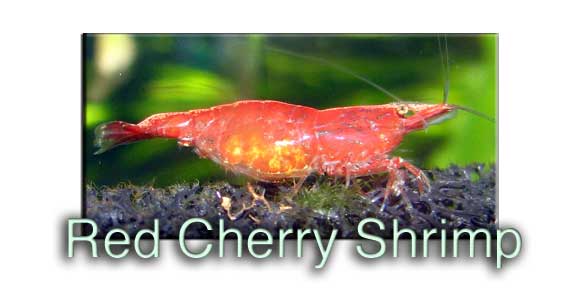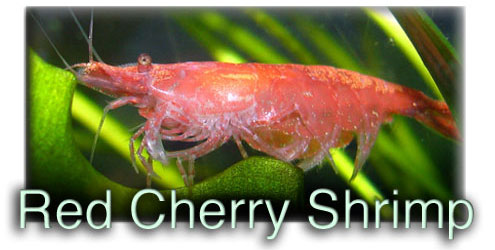 |
||||||||||||||||||||||||||
|
||||||||||||||||||||||||||
|
Caring for RCSBasicsThe ideal tank for RCS is a planted tank. They do really well with lots of plants to filter and clean the water and provide shelter. They are very temperamental to water parameters, so its key to having a well cycled tank prior to introduction. Any excess ammonia can cause a population collapse. The RCS should be kept in a tank no smaller than 2.5 gallons. I personally find it hard to get them to breed in anything smaller than a 10 gallon, but it is possible to have a healthy colony in a smaller tank with adequate care. The tank lights should remain on about 6-8 hours a day. Two 4-hour sessions are most ideal. Do not turn the lights on in total darkness. The sudden change in light can shock a shrimp. Large aggressive fish will eat the RCS and should not be housed together. If there are large fish in the aquarium, you may never see your RCS since they will hide all the time. Smaller fish like endlers, neons, and guppies are okay as long as there are enough hiding places for them to relax or molt. Please to not place the tank near a door that is constantly slamming, they can be distressed and its not good for the growth of the colony. Do not use COPPER in any part of the tank, it is poisonous to shrimp. Be careful if you use fertilizers or any additives to your tank. Fertilizer with small amounts of copper may not harm the entire population, but can cause deaths in young shrimp. I noticed a decline in my shrimp population the months I was using diluted fertilizer. I have heard anubias, the plant, can harm shrimp as well. When a leaf is damaged, it will produce a toxin that can harm and kill some shrimp. If the leaves are not damaged, and remain intact, it may be okay. I personally do not risk it, and refrain from using them in my aquariums. Be careful of the temperature change between night and day when the lights are turned off. Certain lights can increase tank temperatures to harmful levels. Make sure there is no more than a 4 degree temperature change between night and day. Anymore than this can distress your shrimp and lead to short life spans.DietThe RCS will eat a variety of things being omnivores. I feed them shrimp pellets most regularly. They will also eat dead fish, flakes, algae wafers, vegetables and algae. The food should remain present for about two hours for them to fully eat. Make sure there are enough particles so they do not fight over the food. They do not require daily feeding and can be feed every few days. The majority of their diet should consist of Algae, planted aquariums are ideal for RCS. They graze and clean plants all day long keeping them clean. They even eat hair algae and fungus. Sometimes they have difficulty eating the hard algae spots on the glass. It is important to feed your shrimp occasional treats like thawed peas or other soft vegetables. I mostly feed them peas, thawed, not from can, since most can vegetables contain unnecessary preservatives.Color VariationsThe RCS can vary from dark full red to an almost clear blotchy red pattern. Juveniles are not as red as the adults. Some RCS will have a stripe down their back, this is normal. The color of the substrate is a major key to the RCS color intensity. Darker substrate makes the RCS much redder and sticks out much brighter. Light colored substrate and sand make the RCS much less intense and males and juveniles can appear clear sometimes. If there is a yellow/gold spot located on the upper back behind the head, do not worry, this is the "saddle". A saddle is something a shrimp develops before she is ready to carry eggs.GenderThe male RCS is smaller and not as red as the female. The female is larger, redder and carry eggs. Besides color and size the undercarriage is another factor to determine sex. The males undercarriage is straighter, thinner and can sometimes look straight. The females undercarriage will be much fuller than the males and curved in the shape of an upside down rainbow or a "u".BehaviorThe RCS is a mild non-aggressive shrimp. They are frightened of sudden noises and bright lights. They hide a good deal of the day and should not be kept with aggressive fish. You will never see the entire population at once. There are always some that hide at feeding time. I would estimate around 30% or less of shrimp can be seen at an given time. Less than half of the shrimp are present at feeding times. These are very social creatures and do well in large groups. BreedingUsually within two months of age, the RCS juvenile should be ready to carry eggs. Some conditions alter this age within a few weeks. After a molt, the female is most prone to accepting sperm from a male. Once berried (carrying eggs) A females color becomes a darker fuller "red" then of juvenile age. CompatibilityThe RCS should not be kept with Yellow shrimp, Snowball shrimp, Blue pearl shrimp or the wild versions of any of the three shrimp. Each one of these shrimp listed has been bred from the wild version of the RCS. It a brown shrimp with speckles, and the color morphs have been bred from it. If any of these color morphs breed, the outcome will be brown babies. |










